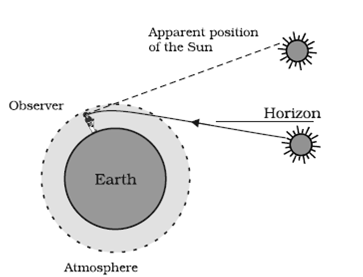What is atomic refraction? use this phenomenon to explain twinkling of star, advance sunrise and delayed sunset. Draw a ray diagram to illustrate your answer? ( CBSE 2016, 2015, 2014, 2012, 2011)
The atmospheric refraction is defined as the phenomenon of refraction of light due to change in the refractive index at a different level in the atmosphere. Light gets refracted at different layers of the atmosphere. The air just above the radiator becomes hotter than the air farther up. Since the hotter air is less dense than, the cooler air above it and has less refractive index than cooler air. The physical conditions of the atmosphere are not the same, the apparent position of the object through hot air fluctuates. This is known as atmospheric refraction.
(a) Twinkling of stars: Twinkling of stars is due to atmospheric refraction of starlight. The starlight after entering the earth’s atmosphere undergoes refraction in a continuous manner before it reaches the Earth. The atmospheric refraction is due to change in the refractive index at a different level in the atmosphere. The starlight bends towards the normal. The apparent position is different from the actual position of the star. Since the atmosphere is not stationary and keeps changing. As the path of rays of light coming from star varies slightly then the apparent position of the star also varies slightly and the amount of light entering the eye flickers. Sometimes, it is brighter, and sometimes the star seems fainter. In this way, stars twinkle.

(b) The advance sunrise and sunset occurs due to the phenomenon of atmospheric refraction. The Sun is visible to us before 2 minutes in sunrise and 2 minutes after the sunset. The actual sunrise means the time when the sun crosses the horizon.
Explanation:
The layer of air nearer to earth are denser than those above it. At sunrise and sunset when the sun is below the horizon, the light rays starting from the sun are incident on these layers. They pass through successively denser layers and thus get bend more and more towards the normal until they fall upon the eye of the observer. To the observer, these rays appear to come from the apparent position of the sun which is above the horizon. It is for this reason that the sun is visible to us a little before it rises above the horizon and so also until it sets below the horizon.
The difference in time is about 2 minutes each for an early rise and late setting of sun
